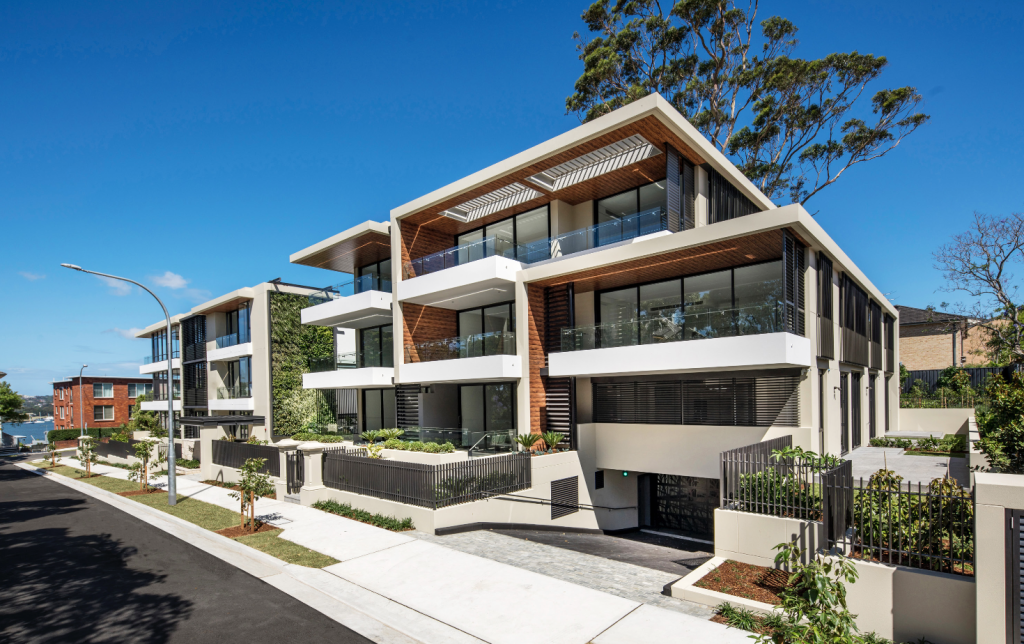From ‘Wild West’ to Gold Standard: How NSW’s Building Commissioner Revitalised a $24 Billion Industry
Buyer confidence returns to the multi- residential market as certification kicks in
There was a time not so long ago that the NSW building industry was referred to as the Wild West. One in 10 new residential apartment blocks in NSW had serious defects and there was no way to tell the good developers from the bad, as buyers crossed their fingers and hoped for the best when choosing a new apartment. As NSW Building Commissioner David Chandler joked, people buying new apartments had less consumer protection than someone buying a toaster or washing machine.
Add to that the scenes that played out on the nightly news of the thousands of residents evacuated from their Sydney Olympic Park apartment block on Christmas Eve 2018 as it threatened to collapse, followed by the 130 residents given hours to flee their Mascot apartment months later.
Into this scenario stepped the first ever NSW Building Commissioner, David Chandler. In just four short years, he has managed to bring a new transparency and confidence to the $24 billion industry. As one industry expert put it, “he managed to turn the Titanic around” not only because of the positive changes he brought to the industry, but the speed with which he did it.
“I remember back in the day the barbecue conversation was ‘You wouldn’t buy an apartment built in the last 10 years’,” says Urban Development Institute of Australia NSW CEO, Steve Mann.
“That was probably not right but there were enough problems for that to be a reasonable conclusion for consumers. We lost the confidence of consumers and no industry can afford to do that.
“So, although that was just true of the fringes (of the industry), we had to hone in on those fringes and reign it in.
“And that required very strong leadership.”
It is almost universally accepted in the building industry that one of the most positive changes in recent years is the introduction of the independent Construction Industry Rating Tool (iCIRT). It allows consumers buying a new or off-the-plan apartment in NSW to check the credentials of the company delivering the work.

So far, more than 200 companies have been rated through an independent and rigorous process, which experts claim is giving consumers the power to choose wisely, for the first time ever, who builds their home.
“Consumers are now asking for iCIRT ratings when visiting display units,” says Karen Stiles, director of the Owners Corporation Network of Australia. “And savvy real
estate agents are now focused on marketing rated developments.”
Fabrizo Perilli, the NSW president of the Property Council of Australia, calls iCIRT a “catalyst for change” in the multi-residential property industry.
“We are yet to see consumer confidence and the purchasing of apartments return to pre-COVID levels, however we anticipate this to improve as more and more developers and builders adopt the iCIRT rating,” he says.
“In the current market, trust, transparency and certainty are paramount for buyers and investors.” Perilli adds it’s also an effective way for developers and builders to differentiate themselves from their peers when communicating to purchasers who are rightly seeking an additional layer of certainty and peace of mind.

NSW chapter president of the Australian Institute of Architects, Adam Haddow, says Chandler’s cleaning up of the industry benefits not only consumers, but all elements involved in the building process.
“From an architect’s point of view, the checks and balances that Chandler has been able to put in has reigned in some of the challenges we felt with the construction of apartments,” the director of architecture firm SJB says. “Before Chandler came in, a lot of things like materials could be swapped out during the construction process and we had little control.
“He brought in more constraints over what can be changed, so you just can’t swap brickwork for aluminium, for example. Most new apartments in NSW are sold off the
“plan and consumers commit to buying an apartment on the info provided during the marketing phase. Now there’s more consumer confidence that they will get the product they committed to.”
While Chandler’s four-year role was due to expire in August, the Minns Government has encouraged him to stay on until the new Building Commission is established by the end of 2023.
The Building Commission was a Minns election promise to ensure quality building and an increase of supply to stem the ongoing housing crisis that has dominated public debate in recent months.
Despite the positive changes, Mann says the apartment sector is “in turmoil” in terms of supply. At its peak in 2018/19 new apartment builds represented almost half of all new housing stock, delivering around $33,000 apartments a year. Mann says that number is down to around 10,000, highlighting a crisis in housing shortage.
“We have a whole lot of economic challenges,” he says.
“There has been layer upon layer of challenges, through the COVID years, the financing of these big projects and construction costs have become more difficult.
“But with the deep affordability challenge we’ve got, apartments must be the big future, it has to be.”
President of the Strata Community Association of NSW, Stephen Brell, agrees.
“The government has predicted NSW needs 30,000 strata lots per year just to keep pace with current demand and given that we are falling behind, that is a challenge for the government and for the planners,” Brell says.
“With affordability, in Sydney in particular, being very expensive the Minns Government has a focus on medium-density living, particularly around the major transport hubs of Sydney. As Sydney is bounded by national parks to the north and south, mountains to the west and the ocean to the east, the only way is to go up.”
Brell adds the future of the apartment sector in NSW looks bright because Chandler is not only looking to improve the quality of new builds, but also to maintain the existing stock.
“By 2030, 60 percent of strata schemes will be more than 30 years old so we need to focus attention on existing buildings, of properly maintaining them,” Brell says.
“We have to make the industry resilient going into the future.”
This stylish family home combines a classic palette and finishes with a flexible floorplan
Just 55 minutes from Sydney, make this your creative getaway located in the majestic Hawkesbury region.
As Paris makes its final preparations for the Olympic games, its residents are busy with their own—packing their suitcases, confirming their reservations, and getting out of town.
Worried about the hordes of crowds and overall chaos the Olympics could bring, Parisians are fleeing the city in droves and inundating resort cities around the country. Hotels and holiday rentals in some of France’s most popular vacation destinations—from the French Riviera in the south to the beaches of Normandy in the north—say they are expecting massive crowds this year in advance of the Olympics. The games will run from July 26-Aug. 1.
“It’s already a major holiday season for us, and beyond that, we have the Olympics,” says Stéphane Personeni, general manager of the Lily of the Valley hotel in Saint Tropez. “People began booking early this year.”
Personeni’s hotel typically has no issues filling its rooms each summer—by May of each year, the luxury hotel typically finds itself completely booked out for the months of July and August. But this year, the 53-room hotel began filling up for summer reservations in February.
“We told our regular guests that everything—hotels, apartments, villas—are going to be hard to find this summer,” Personeni says. His neighbours around Saint Tropez say they’re similarly booked up.
As of March, the online marketplace Gens de Confiance (“Trusted People”), saw a 50% increase in reservations from Parisians seeking vacation rentals outside the capital during the Olympics.
Already, August is a popular vacation time for the French. With a minimum of five weeks of vacation mandated by law, many decide to take the entire month off, renting out villas in beachside destinations for longer periods.
But beyond the typical August travel, the Olympics are having a real impact, says Bertille Marchal, a spokesperson for Gens de Confiance.
“We’ve seen nearly three times more reservations for the dates of the Olympics than the following two weeks,” Marchal says. “The increase is definitely linked to the Olympic Games.”

Getty Images
According to the site, the most sought-out vacation destinations are Morbihan and Loire-Atlantique, a seaside region in the northwest; le Var, a coastal area within the southeast of France along the Côte d’Azur; and the island of Corsica in the Mediterranean.
Meanwhile, the Olympics haven’t necessarily been a boon to foreign tourism in the country. Many tourists who might have otherwise come to France are avoiding it this year in favour of other European capitals. In Paris, demand for stays at high-end hotels has collapsed, with bookings down 50% in July compared to last year, according to UMIH Prestige, which represents hotels charging at least €800 ($865) a night for rooms.
Earlier this year, high-end restaurants and concierges said the Olympics might even be an opportunity to score a hard-get-seat at the city’s fine dining.
In the Occitanie region in southwest France, the overall number of reservations this summer hasn’t changed much from last year, says Vincent Gare, president of the regional tourism committee there.
“But looking further at the numbers, we do see an increase in the clientele coming from the Paris region,” Gare told Le Figaro, noting that the increase in reservations has fallen directly on the dates of the Olympic games.
Michel Barré, a retiree living in Paris’s Le Marais neighbourhood, is one of those opting for the beach rather than the opening ceremony. In January, he booked a stay in Normandy for two weeks.
“Even though it’s a major European capital, Paris is still a small city—it’s a massive effort to host all of these events,” Barré says. “The Olympics are going to be a mess.”
More than anything, he just wants some calm after an event-filled summer in Paris, which just before the Olympics experienced the drama of a snap election called by Macron.
“It’s been a hectic summer here,” he says.

AFP via Getty Images
Parisians—Barré included—feel that the city, by over-catering to its tourists, is driving out many residents.
Parts of the Seine—usually one of the most popular summertime hangout spots —have been closed off for weeks as the city installs bleachers and Olympics signage. In certain neighbourhoods, residents will need to scan a QR code with police to access their own apartments. And from the Olympics to Sept. 8, Paris is nearly doubling the price of transit tickets from €2.15 to €4 per ride.
The city’s clear willingness to capitalise on its tourists has motivated some residents to do the same. In March, the number of active Airbnb listings in Paris reached an all-time high as hosts rushed to list their apartments. Listings grew 40% from the same time last year, according to the company.
With their regular clients taking off, Parisian restaurants and merchants are complaining that business is down.
“Are there any Parisians left in Paris?” Alaine Fontaine, president of the restaurant industry association, told the radio station Franceinfo on Sunday. “For the last three weeks, there haven’t been any here.”
Still, for all the talk of those leaving, there are plenty who have decided to stick around.
Jay Swanson, an American expat and YouTuber, can’t imagine leaving during the Olympics—he secured his tickets to see ping pong and volleyball last year. He’s also less concerned about the crowds and road closures than others, having just put together a series of videos explaining how to navigate Paris during the games.
“It’s been 100 years since the Games came to Paris; when else will we get a chance to host the world like this?” Swanson says. “So many Parisians are leaving and tourism is down, so not only will it be quiet but the only people left will be here for a party.”
This stylish family home combines a classic palette and finishes with a flexible floorplan
Just 55 minutes from Sydney, make this your creative getaway located in the majestic Hawkesbury region.


















